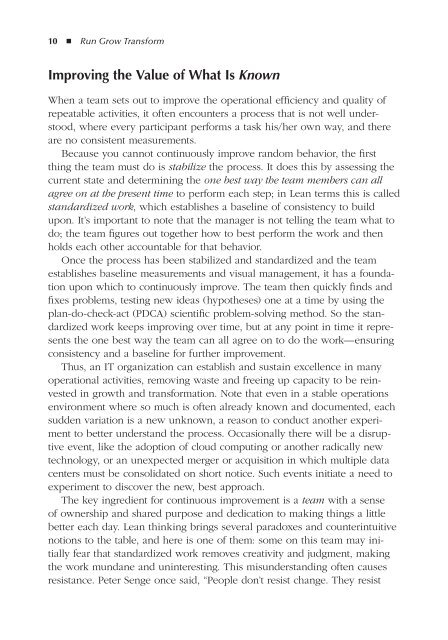Run-Grow-Transform-Chapter-One-distribute-freely
Run-Grow-Transform-Chapter-One-distribute-freely
Run-Grow-Transform-Chapter-One-distribute-freely
Create successful ePaper yourself
Turn your PDF publications into a flip-book with our unique Google optimized e-Paper software.
10 ◾ <strong>Run</strong> <strong>Grow</strong> <strong>Transform</strong><br />
Improving the Value of What Is Known<br />
When a team sets out to improve the operational efficiency and quality of<br />
repeatable activities, it often encounters a process that is not well understood,<br />
where every participant performs a task his/her own way, and there<br />
are no consistent measurements.<br />
Because you cannot continuously improve random behavior, the first<br />
thing the team must do is stabilize the process. It does this by assessing the<br />
current state and determining the one best way the team members can all<br />
agree on at the present time to perform each step; in Lean terms this is called<br />
standardized work, which establishes a baseline of consistency to build<br />
upon. It’s important to note that the manager is not telling the team what to<br />
do; the team figures out together how to best perform the work and then<br />
holds each other accountable for that behavior.<br />
Once the process has been stabilized and standardized and the team<br />
establishes baseline measurements and visual management, it has a foundation<br />
upon which to continuously improve. The team then quickly finds and<br />
fixes problems, testing new ideas (hypotheses) one at a time by using the<br />
plan-do-check-act (PDCA) scientific problem-solving method. So the standardized<br />
work keeps improving over time, but at any point in time it represents<br />
the one best way the team can all agree on to do the work—ensuring<br />
consistency and a baseline for further improvement.<br />
Thus, an IT organization can establish and sustain excellence in many<br />
operational activities, removing waste and freeing up capacity to be reinvested<br />
in growth and transformation. Note that even in a stable operations<br />
environment where so much is often already known and documented, each<br />
sudden variation is a new unknown, a reason to conduct another experiment<br />
to better understand the process. Occasionally there will be a disruptive<br />
event, like the adoption of cloud computing or another radically new<br />
technology, or an unexpected merger or acquisition in which multiple data<br />
centers must be consolidated on short notice. Such events initiate a need to<br />
experiment to discover the new, best approach.<br />
The key ingredient for continuous improvement is a team with a sense<br />
of ownership and shared purpose and dedication to making things a little<br />
better each day. Lean thinking brings several paradoxes and counterintuitive<br />
notions to the table, and here is one of them: some on this team may initially<br />
fear that standardized work removes creativity and judgment, making<br />
the work mundane and uninteresting. This misunderstanding often causes<br />
resistance. Peter Senge once said, “People don’t resist change. They resist<br />
TAF-K14527-12-0302-C001.indd 10<br />
13/08/12 8:25 PM


